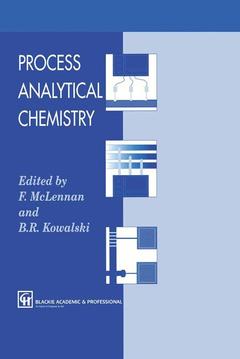Description
Process Analytical Chemistry, Softcover reprint of the original 1st ed. 1995
Coordinators: McLennan F., Kowalski B.D.
Language: English
Subjects for Process Analytical Chemistry:
Keywords
analytical chemistry; chemistry; chromatography; spectroscopy
Publication date: 09-2012
378 p. · 15.5x23.5 cm · Paperback
378 p. · 15.5x23.5 cm · Paperback
Description
/li>Contents
/li>Comment
/li>
Process analytical chemistry (PAC) can be defined as the technology of obtaining quantitative and qualitative information about a chemical process in order to control or optimise its performance. This highly practical book provides an up-to-date introduction to the field with a special emphasis placed on industrial processes. Edited by representatives from one of the world's leading chemical companies and centres of excellence for research into the subject, the book is written by a transatlantic team of authors who provide a global perspective.
1 Process analytical chemistry in perspectivel.- 1.1 Introduction.- 1.2 Terminology.- 1.3 An integrated approach.- 1.4 Technology and instrumentation.- 1.5 PAC maintenance and support.- 1.6 Safety.- 1.7 Information sources.- References.- 2 Sampling systems.- 2.1 Introduction.- 2.2 Sample points.- 2.3 Preconditioning system.- 2.4 Sample transport.- 2.5 Conditioning system.- 2.6 Stream selection.- 2.7 Sample disposal.- 3 Physical property analyzers.- 3.1 Introduction.- 3.2 Viscosity measurement.- 3.3 Boiling point measurement.- 3.4 Flash point measurement.- 3.5 Pour point, cloud point and associated measurements.- 3.6 Vapor pressure measurement.- 3.7 Density and specific gravity measurement.- 3.8 Heating value measurement.- 3.9 Measurement of octane number.- 3.10 Refractive index measurement.- 3.11 Thermal conductivity measurement.- Reference.- 4 Process chromatography.- 4.1 Historical perspective of process chromatography.- 4.2 A simple chromatography model.- 4.3 Process gas chromatography.- 4.4 Liquid chromatography.- 4.5 Process supercritical fluid chromatography.- 4.6 Ion chromatography.- 4.7 Programmer/controller/communication.- References.- 5 Flow injection analysis.- 5.1 Introduction.- 5.2 Fundamental principles.- 5.3 Instrumentation.- 5.4 FI methodologies.- 5.5 Process applications.- 5.6 Conclusions.- References.- 6 Molecular spectroscopy.- 6.1 Introduction.- 6.2 Optical spectroscopy.- 6.3 Process mass spectrometry.- References.- 7 Electrochemical methods.- 7.1 Introduction.- 7.2 Potentiometry.- 7.3 Amperometry.- 7.4 Conclusions.- References.- 8 Process chemometrics.- 8.1 Introduction.- 8.2 Definition.- 8.3 Process monitoring.- 8.4 Multivariate calibration.- 8.5 Non-linear calibration methods.- 8.6 Intrument standardization.- 8.7 Process modeling.- 8.8 Process control.- 8.9 The future.- Acknowledgment.- References.- 9 Environmental monitoring for a sustainable future: From pollution control to pollution prevention.- 9.1 Introduction.- 9.2 Environmental monitoring.- 9.3 Regulatory concerns.- 9.4 Environmental monitoring technology.- 9.5 The future.- References.- 10 Non-invasive techniques.- 10.1 Introduction.- 10.2 Benefits and drawbacks.- 10.3 Techniques.- 10.4 Conclusions.- References.- 11 Future developments of chemical sensor and analyzer systems.- 11.1 Introduction.- 11.2 The higher order approach to array sensing.- 11.3 Optical sensing.- 11.4 Silicon processing for sensor development.- 11.5 Acoustic sensing.- 11.6 Metal oxide semiconductor sensors.- 11.7 Ion selective electrodes.- 11.8 Conclusion.- References.
'This is an interesting book...students in analytical chemistry and chemical engineering will find it useful supplementary reading.'Analysis Europa'Each chapter is self-contained and can be read independently of the others, a useful feature given the scope of the book. Most of the chapters are purely descriptive and...contain many useful tips and much sound advice...This book will give hints and encouragement to those, all too few, technology champions who follow the trends and collaborate with the scientific and technical world outside their own group.'Analyst'This book is written in a readable style, and the information is presented in such a way as to be intelligible to the non-specialist.'Chemistry and Industry
© 2024 LAVOISIER S.A.S.
These books may interest you

Analytical Chemistry 293.64 €



